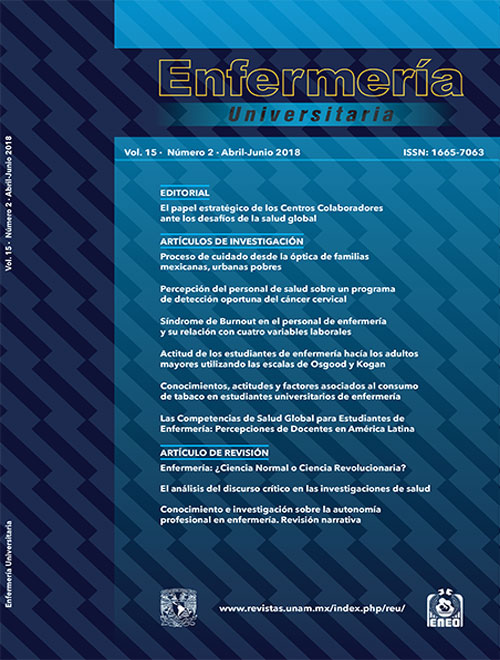Knowledge, attitudes, and factors associated with tobacco use among university nursing students
Main Article Content
Abstract
Objective: To determine factors associated with tobacco use among students in the baccalaureate nursing program of the State of Morelos Autonomous University.
Methods: This a transversal study with 481 students who answered a self-administered questionnaire on issues of social and demographical characteristics and attitudes and knowledge towards tobacco use. Associated factors were analyzed through a multiple logistic regression model.
Results: The overall active smoking prevalence was 42.2%. A higher figure was found in the first year students in comparison to senior students (44.3% vs 13.9%). Some associated factors were: being male (OR = 1.7; CI 95% (1.0 - 3.0)); watching cigarettes being sold (OR = 9.3; CI 95% (3.8 - 23.0)); having all friends being smokers (OR = 6.0; CI 95% (1.3 - 27.7)); being in disagreement with prohibition publicity and smoking-banned places (OR = 3.2; CI 95% (3.0 - 5.2)); and having parents unaware of their sons’ smoking habits (OR = 6.9; CI 95% (3.3 - 14.6)).
Conclusions: Although students tend to decrease their tobacco use while they progress along their careers, it is recommended to incorporate into nursing baccalaureate programs diverse topic discussions on the health impacts from tobacco smoking in order to train the students in its prevention, control, and withdrawal.
Publication Facts
Reviewer profiles N/A
Author statements
- Academic society
- N/A
- Publisher
- Universidad Nacional Autónoma de México
Article Details
Dimensions citation
MÉTRICAS
Enfermería Universitaria by Universidad Nacional Autónoma de México it is distributed under the License Creative Commons Attribution - NonCommercial - NoDerivatives 4.0 International
Accepted and published articles become open-access under the terms of the Creative Commons CC BY-NC-ND 4.0 license, which authorizes the reproduction and sharing without commercial purposes, provided the corresponding acknowledgments to their authors. Authors are allowed to manage a self-archive copy of the article’s published version so that they can open-access it in their personal or institutional web pages, and/or any other broad-diffusion space.


